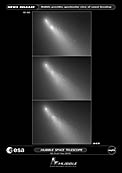Spectacular view of ongoing comet breakup
Hubble Space Telescope is providing astronomers with extraordinary views of Comet 73P/Schwassmann-Wachmann 3. The fragile comet is rapidly disintegrating as it approaches the Sun. Hubble images have uncovered many more fragments than have been reported by ground-based observers. These observations provide an unprecedented opportunity to study the demise of a comet nucleus. The comet is currently a chain of over 33 separate fragments, named alphabetically, stretching across the sky by several times the angular diameter of the Moon. Hubble caught fragment B during three days shortly after large outbursts in activity (from top to bottom: 18 April, 19 April and 20 April). Hubble shows several dozen "mini-comets" trailing behind each main fragment, probably associated with the ejection of house-sized chunks of surface material. Deep-freeze relics of the early Solar System, cometary nuclei are porous and fragile mixes of dust and ices that can break apart due to the thermal, gravitational, and dynamical stresses of approaching the Sun. Whether any of the many fragments survive the trip around the Sun remains to be seen in the weeks ahead.
Credit:About the Image
| Id: | heic0605a |
| Type: | Collage |
| Release date: | 27 April 2006, 19:00 |
| Related releases: | heic0605 |
| Size: | 1275 x 2760 px |
About the Object
| Name: | Comet 73P/Schwassmann-Wachmann 3, Fragment B |
| Type: | Solar System : Interplanetary Body : Comet : Nucleus |
| Category: | Solar System |
Colours & filters
| Band | Wavelength | Telescope |
|---|---|---|
| Optical V | 606 nm |
Hubble Space Telescope
ACS |

